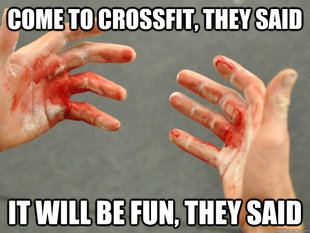Man, has CrossFit stood the
test of time. I mean it has undoubtedly become more and more popular by the
day, for reasons I cannot understand. But I digress. CrossFit’s National Games
are on ESPN, the athletes are becoming more and more well known, and the
affiliations with major corporations and companies in America prove that the
people love CrossFit. I have the utmost respect for those who practice CrossFit
professionally, and if doing CrossFit is your way of getting in shape and it’s
something you genuinely like, then so be it, all the power to you.
But there’s one thing people
need to realize before they start doing CrossFit, whether it’s on their own, at
a CrossFit certified gym, or with a CrossFit certified trainer. In my opinion, there is no doubt that CrossFit comes with a
higher risk of injury in comparison with normal strength training and cardio
workouts.
People fail to realize that
the CrossFit pros are ridiculous athletes. And a quick thirty-second YouTube
search for “CrossFit fails” can show you some of the scariest moments in
exercise history. It’s just a riskier form of exercise, a greater hazard to
burn calories, and a more dangerous method to build strength.
Do people really love doing
ridiculously inefficient movements with extremely high risk of injury? Before I
get to why you should think twice before you do CrossFit, let me reiterate: do
whatever type of fitness it is that makes you enjoy the process and get
results. But just realize there are safer ways to go about this.
Too Much Emphasis on More
Weight and More Reps
The first problem I have
with CrossFit is the constant obsession to put up higher weight and perform
more reps in a smaller time frame. Is it great to better yourself and strive
for improvement? Of course. But when you’re sacrificing proper form and safe
movements to just squeeze out a few more reps of “snatches,” you’re putting
yourself at a greater risk for injury.
Your average CrossFit
athlete will just completely disregard his form in an effort to put in more
work. They’re addicted to beating their previous times, almost to a fault. Whether
this work is more weight, more reps, or a shorter duration, often time form is
thrown out the window. When someone is performing reps of Squat Jumps and
trying to get more reps in a 60-second window than last time, they become
obsessed with the results and not the form or process. They begin to let their
knees cave in, knees extend over their toes, or fail to keep their chest up and
back erect. Or they barely go down low enough to really engage the hamstring
and gluteus muscle. Now not only are you at a greater risk of injury, you’re
performing an inefficient exercise and not working the intended muscles to
their full range of motion.
Instead of focusing on more, I always implore clients to focus
on doing it right. It’s great that
you can do 50 pull-ups in a row. But if the form is a swinging motion that is more
for your forearms and shoulders and not your latissimus dorsi and other back
musculature, then it defeats the purpose of performing a pull up.
Lack of Attention In CrossFit
Classes
Most, not all, but most CrossFit
classes are really just 10-15 people following a dry erase whiteboard of
exercises and trying to complete it as fast as they can with one trainer trying
to watch the form of everyone. It’s impossible.
A good trainer can watch and ensure proper form of maybe 5 people in one
sitting, maybe one or two more. Any more than that and you simply need more
eyes to watch those being instructed.
So when you have 15 people
doing barbell clean and presses in a ratio to one instructor, you have an
environment that is more predisposed to someone getting hurt. Professional CrossFit
athletes know what they are looking for in proper form, and know what they did
wrong when they perform a rep incorrectly. A beginner cannot make that
necessary adjustment, and shouldn’t be expected to make that adjustment. Because
of this, more attention must be paid to the beginners in order to ensure proper
form during the exercise, and safety. Having one trainer watching and
instructing 15 or sometimes more people is not a great way to ensure the safety
of others.
CrossFit Isn’t Training,
It’s Exercise
You want to get bigger,
faster, and/or stronger? Well then CrossFit is not for you, in my opinion.
While you can train your lower body
to have stronger legs when your doing prowler sprints, CrossFit is just a form
of exercise. Lifting weights and using progressive overload is the most
efficient way to make your legs stronger. Doing CrossFit type movements such as
these prowler sprints or squat thrusters are far less efficient to building leg
strength.
CrossFit athletes don’t
perform all CrossFit style workouts day in and day out to improve. To improve
their overhead squat, they do normal barbell back squats and other leg
exercises to strengthen their legs. They do core work to stabilize the spine while
holding a massive load over their head. They don’t do countless reps of the
exercise to improve; they train their
body and other muscles to be better at the exercise. There’s a difference.
And unfortunately many won’t
realize this difference. They’ll attempt to keep adding weight to their
overhead-squats, and since this is a much more dangerous and advanced exercise
than say, a back squat, they are again at risk of injury. The athlete should
focus on improving overall leg strength and core stability before adding more weight to their overhead squat. Not add weight
to the overhead squat to improve that exercise.
Injury
Unfortunately, of the insane
amount of people who sign up for these CrossFit classes, many of them get
injured. Some aren’t as serious as others, maybe some calluses or rolled
ankles, but others are much more serious.
Case in point: Rhabdomyolysis.
Rhabdomyolysis is a potentially fatal condition, which is caused by the
breakdown of muscle cells. Under extreme conditions, your muscle cells explode
and they expire. They then leak out excess amino acids and protein into the
blood stream. Among these proteins that are broken down is myoglobin. Normally
the body would just get rid of the waste, but myoglobin in the blood is
extremely taxing to the kidney and can potentially do great harm to your kidney
in a short amount of time.
Now am I saying this is going to happen? No. But
it’s something to think about when your CrossFit trainer and all of CrossFit
society are pushing you beyond your limit, exercise after exercise. What’s crazy
is Rhabdomyolysis, or more commonly known as Rhabdo, is something some CrossFit
instructors actually know about; yet continue to push people beyond their
limits regularly.
Another problem with pushing yourself constantly
is elevated fatigue levels. By exhausting yourself constantly, you’re tiring out
the rest of your muscles and your central nervous system. After being exhausted
and barely being able to move, try to go do some jump-ups on a 2-foot platform,
and see how hard it is. Unfortunately the culture of CrossFit says push, push,
push, and for those who aren’t ready to handle it put themselves at a greater
probability of injury.
Regrettably, those new to CrossFit view this
culture as a push-it-to-the-limit constant type of exercise, and that’s when
injury, both minor and serious, can really wreak havoc in someone’s life. And
as CrossFit’s founder, Greg Glassman once said about the “sport”, “It can kill
you, I’ve always been completely honest about that.”
Talk about reassuring.
Those Sissy Pull-Ups
Sorry, this truly gets to
me. I hate when I see people claiming they can do 30 pull-ups in a row.
Normally it’s an incredible fitness feat, but when you’re swinging and using
momentum to do 50% of the work, you’ll unfortunately see 50% of the results.
Do a real pull-up – go all
the way down, and use your back, not your arms, to perform the exercise.
So should you completely avoid
CrossFit? No, not completely, but before you engage in CrossFit type training
you need to understand the risks involved. You should do this for any type of
exercise, but with the amount of injuries seen in CrossFit it’s apparent
there’s a greater risk of injury there. It comes down to the age-old question,
“is it really worth the risk?”



Good information here Rich. Thanks for keeping it real.
ReplyDeletethanks for the read!
DeleteI agree with your article Rich. There are definitely pros and cons and one of the things that always gets me is #of reps over proper form. Of COURSE there are people who have great form but I think many times this is the minority. I recently went to see my best friend in a CrossFit competition and I had to look away sometimes at the form people were using in order to make their numbers.
ReplyDeleteIt's unfortunate really. It's almost like your watching in agony hoping they don't hurt themselves
DeleteI'm afraid I disagree. My background is as a sports strength and conditioning coach and I have been in both PT industry and sports since 2001.
ReplyDeleteForm depends on quality of the coach. If communication is the result you get.... keep communicating till you get good form. Our gym is Joe's Garage Gym, we are primarily an S&C studio but we also have a Crossfit affiliation under the name Sweat+Tears CrossFit. On the top of our whiteboard is written"Never, never, never sacrifice form for speed weight or ego"
Rhabdo is also commonly found in endurance sports such as Triathlon and Marathons. It is also more likely if you are dehydrated, an athlete returning to fitness or have been using cocaine (not sure you'd get many cocaine users smashing out a WOD the next day but hey, thems the facts
Kipped pull ups are a valid pull up, just a different sort with a different end result... we use both. Strict chin ups - wide, narrow, weighted, supinated, pronated, towel, climbers on STRENGTH days and we use KIPPED - Orthodox or Butterfly on Conditioning days or Met Con days
The eccentric load of a strict chin up puts more stress on the musclestructure which when done for high reps at intensity can increase the chance of Rhabdo
cheers
Joe
All good, agree to disagree. I appreciate the comment!
DeleteGreat Article. I am a CPT and just started CF classes to see what the hype is all about. I defn agree with what you said above but I am pleased with the affiliate I go to, they are very pro form, pro safety and they do not push you to do what you are incapable of doing. That being said, everyone needs to take responsibility for knowing their own limits if they are going to be taking a $25 per session class rather than pay for personal training and coaching. You get what you pay for remains true here too!
ReplyDeleteSo true, glad you liked the article
DeleteTheres nothing more to say about your article other than. You "F'in" NAILED IT DUDE! I hate looking in crossfit gyms and seeing the train wrecks inside. Xfit is for a certain population not everyone & too many contraindicated moves. Thank god for crossfit injuries will keep me busy rehabbing them.
ReplyDeleteGlad you liked it!
DeleteThe definitive article on the Cross Fit fad! I have printed it out should any of my 'trendier' friends consider joining a Cross Fit gym!
DeleteAnd to Joe, I am sorry, but your disagreement with Rich is actually a reinforcement. Your validation is 'On the top of our whiteboard is written "Never, never, never sacrifice form for speed weight or ego" ...not that instructors are monitoring individual form, progress, and possible overtraining symptoms, customizing programs to individual age, abilities & physical limitations, but basically, 'we wrote it on the whiteboard, so it's not our fault if you get hurt!'
Best EVER
ReplyDeletethank you!
DeleteHi Rich,
ReplyDeletenice article putting together some of the many key points about Crossift anno 2014. I just held a lecture for personal trainers with the title 'Stop exercising, start training' where a lot of the things you mention came into discussion. Via this link you can see the slides, the discussion around was definitely in line with what are you saying. Periodization is a well known, scientifically based habit in endurance sports as well as strength training, but I see a lack of it Crossfit and in many functional exercises offered by trainers who think is 'cool' to jump on a Bosu while holding a TRX in the hands.
My company offers clients and trainers a periodized form of Functional Training based on a 12 week program and we are collecting data to prove the efficiency of it. We only work 1:1 or in groups of max. 6 people, so again you're right about the size of a Crossfit class and the chance of injury. Well done!
http://www.slideshare.net/slideshow/embed_code/32391086
glad you enjoyed the article!
DeleteThanks Rich! I appreciate the fact that the high-end Cross-fit enthusiasts are athletes, yet they too are susceptible (Kevin Ogar's injury). The bottom line; good form, technique and understanding those good old principles of fitness like progression,variability,overload AND periodization. Although many people think it; more is not always better. Also loved you comments on the group training. I am appalled to see individuals calling themselves "trainers" or "instructors" who lead others through these poorly supervised workouts. Total negligence and a poor reflection on the fitness industry. For those of you who ARE promoting good technique and principles of training, don't let the CrossFit hype sway your course.
ReplyDeletethanks, glad you liked it!
DeleteThis is such a great article on pointing out the advantages as well as disadvantages of crossfit.
ReplyDeleteAs a competitive power- lifter , you have got to have such good form on certain lifts to avoid injury. Now take those lifts go as fast as you can plus add other exercises/ lifts to fatique your muscles, that is not for everyone and injuries most definitely will occur.
You need to learn proper form the right way and execute it before throwing other variables into the workout. To me it's common sense and the injuries that could result - nightmare!!
Great read !
Gina
thank you!
Delete